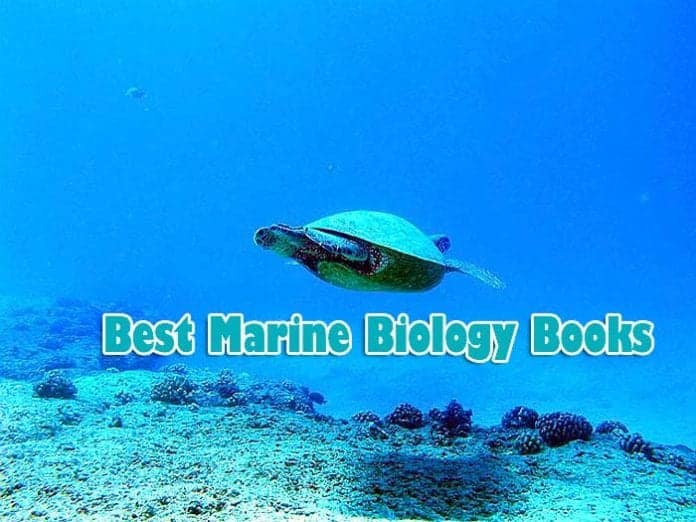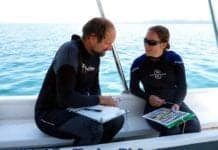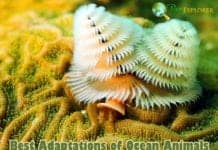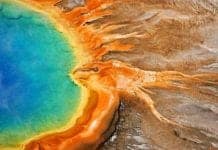
Best Marine Biology Books: Marine biology is both a fascinating and complex field of study. It covers the study of the marine animals and plants, as well as the complex physical and chemical processes that take place in the water.
Table of Contents
- Marine Biology (9th Edition)
- Marine Biology: Function, Biodiversity, Ecology (5th Edition)
- Marine Community Ecology and Conservation (1st Edition)
- Marine Life of the Pacific Northwest (1st Edition)
- Creatures of the Deep: In Search of the Sea’s Monsters and the World They Live In (2nd Edition)
- Essential Invitation to Oceanography (Pap/Psc Edition)
- Oceanography and Marine Biology: An Introduction to Marine Science (1st Edition)
- Ocean: Photicular Book (Hard cover)
- Citizens of the Sea: Wondrous Creatures From the Census of Marine Life (Hard cover)
- The Ocean of Life: The Fate of Man and the Sea (Reprint Edition)
- Invitation to Oceanography (7th Edition)
- The Life and Love of the Sea (Hard cover)
- National Audubon Society Guide to Marine Mammals of the World (Paperback)
- Jellyfish: A Natural History (Hard cover)
- Chemical Oceanography And The Marine Carbon Cycle (1st Edition)
The ocean research has begun relatively recently, as the underwater studies were mostly unavailable for most of human history. At present, we realize how complex and fragile marine ecosystems are.
As the need to protect our oceans grows, the need for better books on the subjects grows as well. Nowadays, there are multiple high-quality textbooks, reference guides, as well as non-fiction books that help the wider audience understand the beauty and fragility of the oceans and the seas.
The marine biology book is regarded as the most authoritative and comprehensive text on modern Marine Biology. The textbook is praised both by professors and students alike.
These marine biology books are useful for students, researchers, as well as for the younger generation. Let us see the best the Amazon bookstore has to offer on this engrossing subject.
Best Marine Biology Books
Here are top-15 hand-picked best marine biology books for students and researchers:
Marine Biology (9th Edition)
 This marine biology textbook covers most topics required for a college-level introductory course on marine biology. The textbook can both be rented and bought from Amazon. This book has several excellent advantages:
This marine biology textbook covers most topics required for a college-level introductory course on marine biology. The textbook can both be rented and bought from Amazon. This book has several excellent advantages:
- The textbook is suitable for students who do not major in Marine Biology.
- This book can be a good read for people who are just interested in science.
- The text is accompanied by high-quality illustrations.
- The textbook has good quizzes and tasks that can be given to students.
- The material covered also includes physical sciences and the basics of the scientific method.
The readers also report some minor disadvantages:
- The quality of the material is uneven.
- The online testing software affiliated with the book does not always work correctly.
- Not all text is clear and concise enough for learners.
![]()
Marine Biology: Function, Biodiversity, Ecology (5th Edition)
 The next marine biology book is regarded as the most authoritative and comprehensive text on modern Marine Biology. The textbook is praised both by professors and students alike because:
The next marine biology book is regarded as the most authoritative and comprehensive text on modern Marine Biology. The textbook is praised both by professors and students alike because:
- The textbook uses a practical teaching approach, explaining marine biology from the ecological point of view.
- The textbook contains good illustrations.
- The style in the book is both conversational and scientific, making learning pleasant.
- The textbook can be helpful both for students without any background on the subject and Marine Biology majors.
- The textbook also includes many data from modern papers.
One should be aware of some drawbacks as well:
- Some readers have found several factual errors, mostly biology-related.
- Not all students like the style and consider the textbook boring.
![]()
Marine Community Ecology and Conservation (1st Edition)
 This textbook is aimed at advanced undergraduate and graduate students. The content of the book reflects that:
This textbook is aimed at advanced undergraduate and graduate students. The content of the book reflects that:
- The book explains how the marine communities are shaped by physical and biological forces within given constraints.
- The authors also discuss several specific benthic communities.
- The textbook also includes chapters devoted to conservation and management.
- The present edition is an extensively upgraded version of the 2001 book, with much novel content based on current research.
- As it is a textbook, the new edition also offers an online resource for instructors with all the relevant material needed for lectures and presentations.
- The only potentially negative feature of the book is a rather advanced content – it is not suitable for learners without a solid background in marine biology.
![]()
Marine Life of the Pacific Northwest (1st Edition)
 This marine biology book is a collection of high-quality photos of the most common marine invertebrates, seaweeds, and fishes that can be found in the Pacific Northwest area. The authors of the book are experienced scuba divers themselves. The book has several attractive features:
This marine biology book is a collection of high-quality photos of the most common marine invertebrates, seaweeds, and fishes that can be found in the Pacific Northwest area. The authors of the book are experienced scuba divers themselves. The book has several attractive features:
- The book illustrations depict species from Southern Alaska to Southern Oregon.
- Each illustration is accompanied by a short introduction on habitat, range, appearance, and behavior.
- There are images of species that were never featured in print before.
- The book is easy to use as a reference source because of a convenient color code.
Despite all the advantages, there are also minor drawbacks:
- The book is rather heavy to take on trips (for example, for scuba divers).
- It is meant as a field guide, not an educational resource for learning about marine animals and plants.
![]()
Creatures of the Deep: In Search of the Sea’s Monsters and the World They Live In (2nd Edition)
 This non-fiction marine biology book is dedicated to discussing and describing so-called “monster” fauna found in the ocean – i.e. , animals that are the subjects of myth, are perceived as unusual or dangerous to humans.
This non-fiction marine biology book is dedicated to discussing and describing so-called “monster” fauna found in the ocean – i.e. , animals that are the subjects of myth, are perceived as unusual or dangerous to humans.
The present edition is updated, as much new research is now available on the subject. There are several reasons why this book was chosen as the best non – fiction of 2002:
- The author describes various species from tiny microbes to giant squid and sharks.
- The book covers not only species descriptions but also various interactions between species.
- The book has excellent illustrations that accompany the text.
- The sea life is organized by strata – from the upper levels to the deep-sea vents.
There are some cons to this book, though:
- The author covers not only deepwater fauna but the animals found at all levels in the water column.
- Half of the book volume are photographs and not text.
![]()
Essential Invitation to Oceanography (Pap/Psc Edition)
 This marine biology textbook intended as an introductory, concise course on oceanography for the non – science students. This book is a popular choice due to several features:
This marine biology textbook intended as an introductory, concise course on oceanography for the non – science students. This book is a popular choice due to several features:
- The textbook does not contain several advanced topics, making it suitable for introductory courses.
- The textbook explains how processes in the ocean are linked to the main four sciences: chemistry, biology, physics, and geology.
- The style is natural for the students to read.
- There is a companion website for students that contains additional information and quizzes.
- The instructors can choose a version with instructor’s materials included.
There are also some disadvantages to this particular edition:
- The book is not suitable for reading on Kindle.
- There are several small factual errors.
- The style does not appeal to everyone equally.
![]()
Oceanography and Marine Biology: An Introduction to Marine Science (1st Edition)
 This marine biology book is written by a professor of oceanography based on his personal teaching experience. The main focus of the book is to teach the complex scientific concepts to undergraduate students that are most interested in the biological aspects of the subject. The book has some positive features because of that:
This marine biology book is written by a professor of oceanography based on his personal teaching experience. The main focus of the book is to teach the complex scientific concepts to undergraduate students that are most interested in the biological aspects of the subject. The book has some positive features because of that:
- The textbook covers both oceanography and marine biology.
- The book combines physical and mathematical aspects with biology in a way that is easier to comprehend for biology majors.
- The arrangement of information in the book allows much flexibility for both the student and the instructor.
- The style in which the textbook is written appeals to students and is informative.
- The only disadvantage noticed by reviewers is a presence of some minor errors.
![]()
Ocean: Photicular Book (Hard cover)
 This educational marine biology book intended for 5-6-old children teaching them the basics of marine life. It contains holographic illustrations that can “move” on the page. There are several reasons why it is a good idea to buy this book:
This educational marine biology book intended for 5-6-old children teaching them the basics of marine life. It contains holographic illustrations that can “move” on the page. There are several reasons why it is a good idea to buy this book:
- The illustrations are very colorful and the images attractive.
- The book is mainly dedicated to coral reefs and contains both bright pictures and simple descriptions.
- The book is suitable for older children as well, because of the excellent content on sea life.
- The book can also be used for classes at primary school.
We can list the following as disadvantages of this particular book:
- The book is pretty small – it contains only 7 “moving” pictures inside.
- The main book focus is on entertainment and not education.
- The price for the book is high.
![]()
Citizens of the Sea: Wondrous Creatures From the Census of Marine Life (Hard cover)
 This is an educational illustrated book released by National Geographic. The marine biology book has many attractive features:
This is an educational illustrated book released by National Geographic. The marine biology book has many attractive features:
- The edition contains high-quality color photographs of marine and coastal fauna.
- The photographs are accompanied by descriptions and interesting scientific facts about each species.
- The information is given in small “bites“, suitable both for young children and non – specialists.
There are some disadvantages, as well:
- Though the book covers a variety of species, it still lacks information and pictures on some of the rarer organisms.
- The book is not very large, and the photos are small.
- Some scientific information is more advanced and is suitable for older children.
![]()
The Ocean of Life: The Fate of Man and the Sea (Reprint Edition)
 This marine biology book is an award-winning non -fiction oceanography book written by Callum Roberts, a marine scientist, and conservationist. This excellent book is devoted to the history of the relationship between humans and the sea. There are several reasons why one should buy this book:
This marine biology book is an award-winning non -fiction oceanography book written by Callum Roberts, a marine scientist, and conservationist. This excellent book is devoted to the history of the relationship between humans and the sea. There are several reasons why one should buy this book:
- The book presents a comprehensive history of marine life, from the earliest life on Earth to the present-day condition of the marine environment.
- The author describes in detail how the situation in our seas has changed in the last 50 years.
- Numerous threats to the ocean are covered, such as acidification, overfishing, and the dangers of plastic pollution.
- This book is sometimes required as a textbook in some college courses related to conservation and sustainability.
- The book includes some possible ways to reduce the negative impact of human activity on the ocean.
There are a few drawbacks to this book:
- The book is a challenging read from the emotional point of view.
- Sometimes descriptions are overly detailed, making reading more difficult.
- This book is drier and does not have an overall “story” arc compared to the previous book by the same author – “The unnatural history of the sea“.
![]()
Invitation to Oceanography (7th Edition)
 This marine/oceanography textbook is intended for the introductory course on Oceanography for undergraduate college students that major in oceanography or marine biology. This textbook has several interesting features that make it a popular choice both for major and non-major students, as well as instructors:
This marine/oceanography textbook is intended for the introductory course on Oceanography for undergraduate college students that major in oceanography or marine biology. This textbook has several interesting features that make it a popular choice both for major and non-major students, as well as instructors:
- The book covers all four scientific aspects of oceanography: physics, geology, chemistry, and biology.
- The text in the book is easy to read.
- There are multiple illustrations and graphs to make the main concepts more understandable.
- The hardcopy of the textbook is also accompanied by the Navigate 2 Advantage Access to an e-book with all the relevant information, as well as student activities and instructor resources.
- The new edition includes much pertinent information, such as the consequences of the recent tsunami in Japan and modern research on climate change.
The students report some disadvantages, though:
- Sometimes the access code that goes with the textbook does not work.
- The style of writing is not suitable for everyone.
- This textbook does not read well on kindle.
- The textbook contains much complex information and requires complete focus to comprehend the concepts presented.
![]()
The Life and Love of the Sea (Hard cover)
 This marine biology book is a collection of beautiful underwater photographs from several famous and well-established photographers. The book has several unique features:
This marine biology book is a collection of beautiful underwater photographs from several famous and well-established photographers. The book has several unique features:
- The collection includes images of the waves, coastal landscapes, coral reefs, as well as various underwater species.
- The images are combined with poetry devoted to the sea.
- The images are big – sometimes they take up not one page, but two.
The disadvantages to this book are few:
- The edition is quite heavy and big.
- This book is predominantly visual, without any substantial information on marine life.
![]()
National Audubon Society Guide to Marine Mammals of the World (Paperback)
 This marine biology field guide covers all 120 species of marine mammals in great detail:
This marine biology field guide covers all 120 species of marine mammals in great detail:
- The book includes descriptions of whales, dolphins, porpoises, manatees, seals, sea lions and even the polar bear.
- The animals described in the guide are organized into 4 separate groups for convenience.
- The information in the book is accompanied by color photographs, maps, charts, and paintings.
- The guide includes information on behavior, habitat, range, as well as history on each species.
- The field guide also includes information on taxonomy and evolution on marine mammals.
- The book contains additional information on animal watching guidelines, as well as conservation organizations that work with marine mammals.
- The book is intended for adults or high school students.
- The book can be used in several college courses, such as courses on behavior and cognition in marine mammals.
There are some minor disadvantages to this particular guide:
- The book does not contain references for the information used, so its use as a reference book is limited.
![]()
Jellyfish: A Natural History (Hard cover)
 This next marine animal book is written by Lisa-Ann Gerschwin, a renowned specialist on jellyfish. This non-fiction book is solely devoted to these animals:
This next marine animal book is written by Lisa-Ann Gerschwin, a renowned specialist on jellyfish. This non-fiction book is solely devoted to these animals:
- The book combines high-quality photographs with the latest scientific information on jellyfish biology.
- The book covers 50 most common jellyfish species.
- The author discusses the biology, natural history, behavior of jellyfish, as well as their role in the overall ocean ecosystem.
- The book is intended for the lay audience without any scientific background, but can also be used as a field guide or a reference book.
![]()
Chemical Oceanography And The Marine Carbon Cycle (1st Edition)
 The last marine biology book is an advanced textbook that provides insight into the chemical processes taking place in the ocean. This book is recommended for the upper-level graduates and undergraduates in such disciplines as oceanography, geochemistry, and environmental chemistry. It has several advantages as a textbook:
The last marine biology book is an advanced textbook that provides insight into the chemical processes taking place in the ocean. This book is recommended for the upper-level graduates and undergraduates in such disciplines as oceanography, geochemistry, and environmental chemistry. It has several advantages as a textbook:
- The book provides a background on thermodynamics, isotope systematics, as well as the influence of life on ocean chemistry.
- The textbook also covers the processes that take place in the course of the marine and atmosphere carbon cycle.
- The book can be used as a reference book for oceanography specialists.
- The book is not suitable as an introduction to chemical oceanography and is better for the audience that is already familiar with the topic.
![]()
The present list combines academic textbooks with the best and most interesting non-fiction books that are suitable for the audience of all ages.
These marine biology books would help you know more about the ocean and the animals that live within it. As life in the ocean is incredibly diverse, this list simply cannot cover all the great books written on the subject.
However, above marine biology books would give a reader a good idea on the marine biodiversity and complexity and would help raise awareness about the dangers our oceans and the planet face every day as a whole.
![]()
















